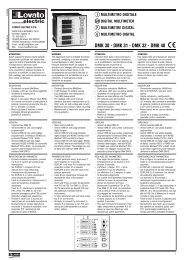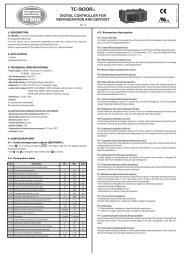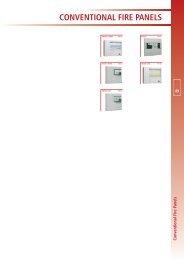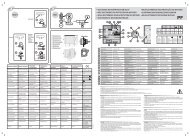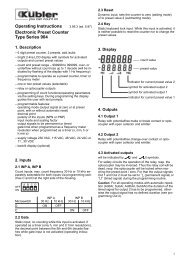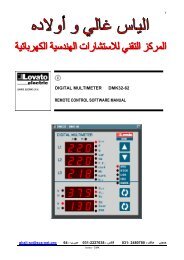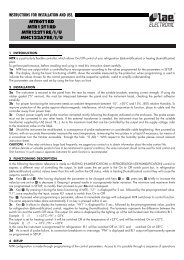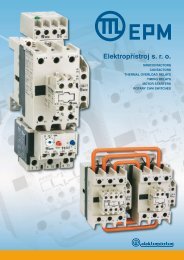NOVAR 1106 / 1114 / 1206 / 1214 NOVAR 1xxx / S400 NOVAR ...
NOVAR 1106 / 1114 / 1206 / 1214 NOVAR 1xxx / S400 NOVAR ...
NOVAR 1106 / 1114 / 1206 / 1214 NOVAR 1xxx / S400 NOVAR ...
You also want an ePaper? Increase the reach of your titles
YUMPU automatically turns print PDFs into web optimized ePapers that Google loves.
<strong>NOVAR</strong> <strong>1xxx</strong> EPM Elektropřístroj s. r. o.<br />
43 section connection time (in<br />
thousands of hours)<br />
44 number of section connections<br />
(in thousands)<br />
45 instrument failure condition<br />
46 instantaneous condition of<br />
control time<br />
50 instrument address 1 ÷ 255 1 1<br />
51 communication rate 600 ÷ 9,600 Bd — 9,600<br />
52 communication protocol KMB(P0) /<br />
— KMB(P0)<br />
Modbus-RTU(P1)<br />
55 power system frequency A (auto) – 50 Hz – — A (auto)<br />
60 Hz<br />
56 average value evaluation moving<br />
window size<br />
57 minimum and maximum value 1 minutes ÷ 7<br />
evaluation moving window size days<br />
display range 0.001 to 130<br />
display range 0.001 to 9999<br />
time until next control intervention in<br />
seconds<br />
1 minute ÷ 7 days — 7 days applies to average values of Acos, APac,<br />
APre<br />
— 15 minutes applies to these minimum and maximum<br />
values: mincos, maxPac, maxPre,<br />
maxdPre<br />
58 Celsius/Fahrenheit temperature °C – °F — °C<br />
display mode<br />
59 cooling enable threshold +10 ÷ +60 °C 1 °C +40 °C not displayed if cooling output not<br />
specified<br />
60 heating enable threshold -30 ÷ +10 °C 1 °C -5 °C not displayed if heating output not<br />
specified<br />
The control bandwidth can be increased to 0.040 or decreased to 0.000 on high loads. Control<br />
bandwidth increase may especially be useful in systems with large control range – avoiding uselessly<br />
precise control on high loads reduces the number of control interventions which results in longer<br />
contactor service life. If the parameter values is decreased to 0, the control bandwidth corresponds to<br />
value C/k min (constant, not widening).<br />
Note: On low loads, the control bandwidth is ―bent‖ (zone A) to prevent undesired overcompensation<br />
(the illustration is a simplification).<br />
If the target power factor (parameter 01/07) is specified in degrees as phase shift angle, the bandwidth<br />
on high loads is also displayed in degrees.<br />
4.1.6 Parameter 06 – Metering Rate 2 Operation<br />
The <strong>NOVAR</strong> controllers feature two sets of the above described control parameters.<br />
Parameter 6 decides if the control process uses the first set of basic control parameters, 1 through 4,<br />
only or if, under certain circumstances, the second set of parameters, 7 through 10 (metering rate 2) is<br />
used as well.<br />
By default parameter 6 is set to and only parameters 1 through 4 of the parameters described<br />
above are applied; parameters 7 through 10 are not significant in such an event, so they are not<br />
shown.<br />
<strong>NOVAR</strong><strong>1206</strong>/<strong>1214</strong> controllers allow changing the above described basic control parameters while<br />
compensation is in progress, triggered by external signal (relay contact). They have a metering rate 2<br />
request input for this operation, to which an insulated contact or optocoupler can be connected. If you<br />
set the parameter to, the controller will start evaluating metering rate 2 requests and, depending on<br />
the input’s instantaneous condition, use parameters 1 through 4 or 7 through 10.<br />
The decimal point after the last character then indicates whether metering rate 2 request is active. If it<br />
is dark, metering rate 2 request is not active and only parameters for metering rate 1 apply. On the<br />
contrary, lit decimal point indicates active metering rate 2 request and the controller uses parameters<br />
specified for metering rate 2.<br />
28



